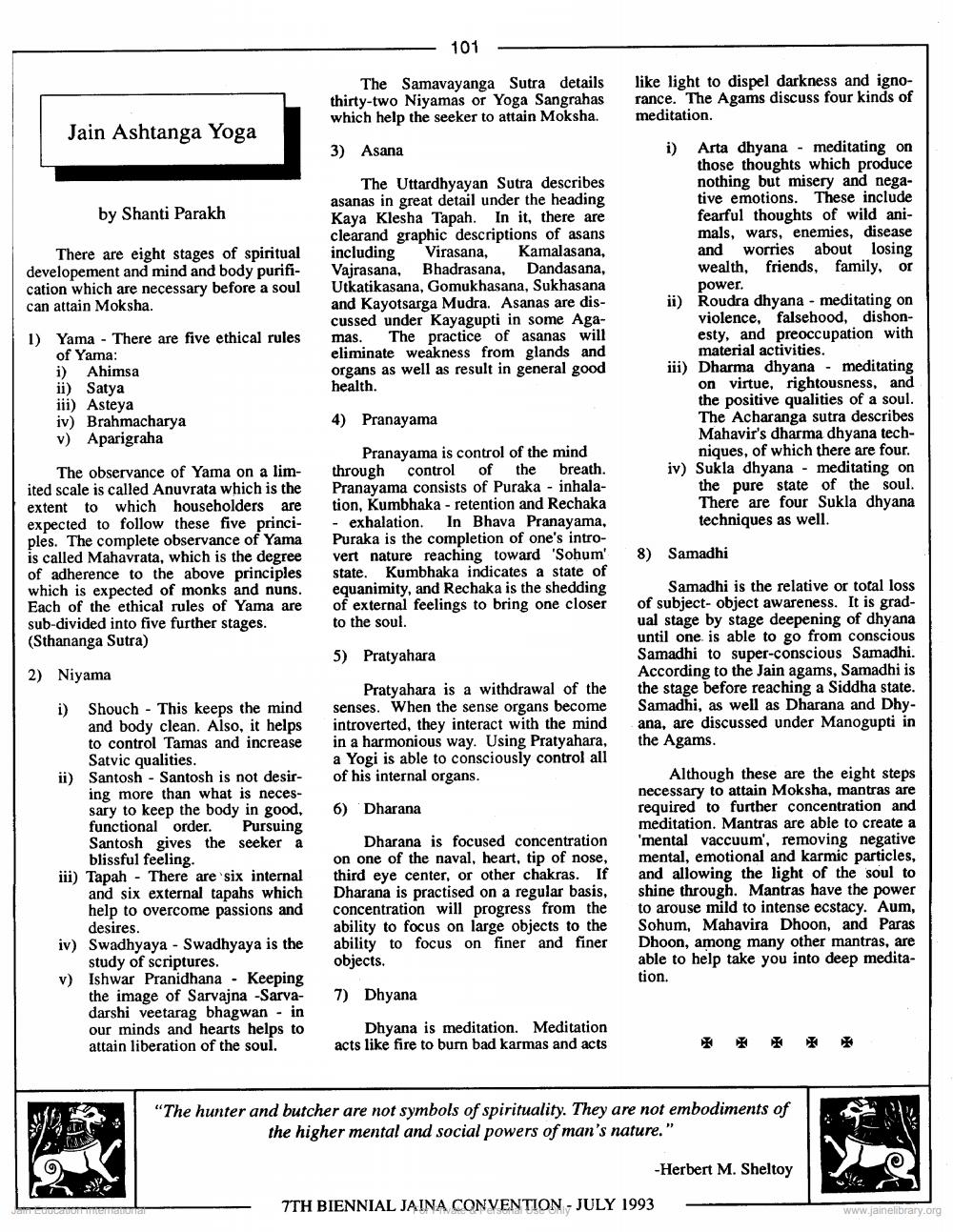________________
Jain Ashtanga Yoga
by Shanti Parakh
There are eight stages of spiritual developement and mind and body purification which are necessary before a soul can attain Moksha.
1) Yama There are five ethical rules of Yama:
i) Ahimsa
ii) Satya
iii) Asteya
iv) Brahmacharya v) Aparigraha
The observance of Yama on a limited scale is called Anuvrata which is the extent to which householders are expected to follow these five principles. The complete observance of Yama is called Mahavrata, which is the degree of adherence to the above principles which is expected of monks and nuns. Each of the ethical rules of Yama are sub-divided into five further stages. (Sthananga Sutra)
2) Niyama
i) Shouch This keeps the mind and body clean. Also, it helps to control Tamas and increase Satvic qualities.
ii) Santosh Santosh is not desiring more than what is necessary to keep the body in good, functional order. Pursuing Santosh gives the seeker a blissful feeling.
iii) Tapah There are six internal and six external tapahs which help to overcome passions and desires.
iv) Swadhyaya - Swadhyaya is the study of scriptures.
v) Ishwar Pranidhana - Keeping
the image of Sarvajna -Sarvadarshi veetarag bhagwan in our minds and hearts helps to attain liberation of the soul.
On international
101
The Samavayanga Sutra details thirty-two Niyamas or Yoga Sangrahas which help the seeker to attain Moksha.
3) Asana
The Uttardhyayan Sutra describes asanas in great detail under the heading Kaya Klesha Tapah. In it, there are clearand graphic descriptions of asans including Virasana, Kamalasana, Vajrasana, Bhadrasana, Dandasana, Utkatikasana, Gomukhasana, Sukhasana and Kayotsarga Mudra. Asanas are discussed under Kayagupti in some Agamas. The practice of asanas will eliminate weakness from glands and organs as well as result in general good health.
4) Pranayama
Pranayama is control of the mind through control of the breath. Pranayama consists of Puraka inhalation, Kumbhaka - retention and Rechaka - exhalation. In Bhava Pranayama, Puraka is the completion of one's introvert nature reaching toward 'Sohum' state. Kumbhaka indicates a state of equanimity, and Rechaka is the shedding of external feelings to bring one closer to the soul.
5) Pratyahara
Pratyahara is a withdrawal of the senses. When the sense organs become introverted, they interact with the mind in a harmonious way. Using Pratyahara, a Yogi is able to consciously control all of his internal organs.
6) Dharana
Dharana is focused concentration on one of the naval, heart, tip of nose, third eye center, or other chakras. If Dharana is practised on a regular basis, concentration will progress from the ability to focus on large objects to the ability to focus on finer and finer objects.
7) Dhyana
Dhyana is meditation. Meditation acts like fire to burn bad karmas and acts
like light to dispel darkness and ignorance. The Agams discuss four kinds of meditation.
i)
Arta dhyana meditating on those thoughts which produce nothing but misery and negative emotions. These include fearful thoughts of wild animals, wars, enemies, disease and worries about losing wealth, friends, family, or power.
ii) Roudra dhyana - meditating on
violence, falsehood, dishonesty, and preoccupation with material activities.
iii) Dharma dhyana - meditating on virtue, rightousness, and the positive qualities of a soul. The Acharanga sutra describes Mahavir's dharma dhyana techniques, of which there are four. iv) Sukla dhyana meditating on the pure state of the soul. There are four Sukla dhyana techniques as well.
8) Samadhi
Samadhi is the relative or total loss of subject- object awareness. It is gradual stage by stage deepening of dhyana until one is able to go from conscious Samadhi to super-conscious Samadhi. According to the Jain agams, Samadhi is the stage before reaching a Siddha state. Samadhi, as well as Dharana and Dhyana, are discussed under Manogupti in the Agams.
Although these are the eight steps necessary to attain Moksha, mantras are required to further concentration and meditation. Mantras are able to create a 'mental vaccuum', removing negative mental, emotional and karmic particles, and allowing the light of the soul to shine through. Mantras have the power to arouse mild to intense ecstacy. Aum, Sohum, Mahavira Dhoon, and Paras Dhoon, among many other mantras, are able to help take you into deep meditation.
*****
"The hunter and butcher are not symbols of spirituality. They are not embodiments of the higher mental and social powers of man's nature."
7TH BIENNIAL JAINA CONVENTION - JULY 1993
-Herbert M. Sheltoy
www.jainelibrary.org




